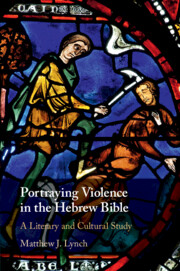Book contents
- Portraying Violence in the Hebrew Bible
- Portraying Violence in the Hebrew Bible
- Copyright page
- Publisher’s note
- Dedication
- Contents
- Acknowledgements
- Abbreviations
- Introduction
- Part I Violence and Ecology
- Part II Violence and Moral Speech
- Part III Violence and Justice
- 6 The Outcry of Violence
- 7 Judicial Responses to Violence
- 8 Violence and the Divine Avenger
- Part IV Violence and Impurity
- Conclusion
- Appendix
- Bibliography
- Index
7 - Judicial Responses to Violence
from Part III - Violence and Justice
Published online by Cambridge University Press: 06 May 2020
- Portraying Violence in the Hebrew Bible
- Portraying Violence in the Hebrew Bible
- Copyright page
- Publisher’s note
- Dedication
- Contents
- Acknowledgements
- Abbreviations
- Introduction
- Part I Violence and Ecology
- Part II Violence and Moral Speech
- Part III Violence and Justice
- 6 The Outcry of Violence
- 7 Judicial Responses to Violence
- 8 Violence and the Divine Avenger
- Part IV Violence and Impurity
- Conclusion
- Appendix
- Bibliography
- Index
Summary
Chapter 7 analyses legal portrayals of the problem of violence, using the Deuteronomic Code as a case study. Deuteronomy focuses on ‘bloodshed’ (using דם) and its legal and communal consequences. Violence threatens relationships between households in Israel, hence its emphasis on males. But it also creates a problem for the community and its relationship to the land. Deuteronomy communicates that the problem of blood ‘in your midst’ (בקרבך) needs to be ‘expelled’ through judicial processes. The land is always a third party to violent crimes in Deuteronomy. Laws pertaining to refuge cities (Deut 19:1-13), the ‘violent witness’ (19:15-21), unknown perpetrators (Deut 21:1-9), the hanging corpse (21:22-23), and sexual violence (Deut 22:25-27) each reflect a concern to expel violence from the whole community of Israel, and in so doing, from the land. Violence, and the outcry it elicited, signalled the breakdown in the relationships constitutive of a just society, and demanded legal resolution. This is why, at times, the term חמס stands in for a range of potential judicial infractions.
- Type
- Chapter
- Information
- Portraying Violence in the Hebrew BibleA Literary and Cultural Study, pp. 167 - 204Publisher: Cambridge University PressPrint publication year: 2020

